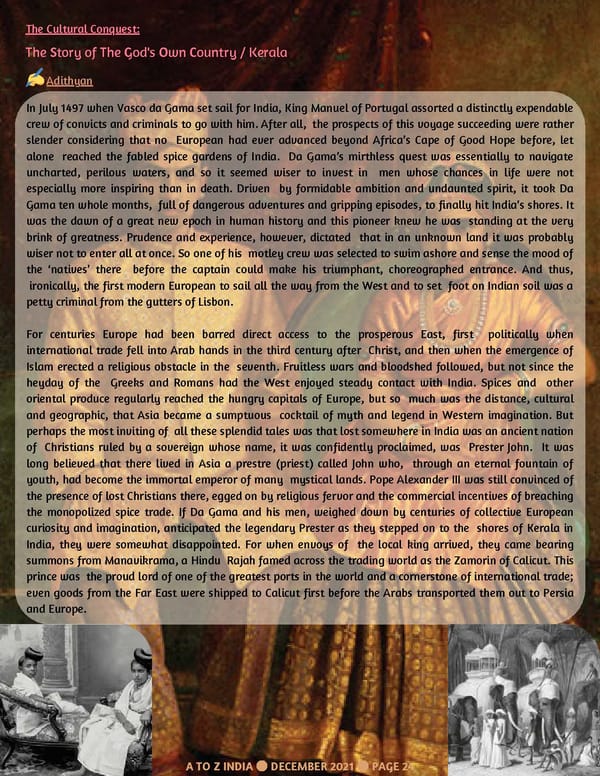The Cultural Conquest: The Story of The God's Own Country / Kerala Adithyan In July 1497 when Vasco da Gama set sail for India, King Manuel of Portugal assorted a distinctly expendable crew of convicts and criminals to go with him. After all, the prospects of this voyage succeeding were rather slender considering that no European had ever advanced beyond Africa’s Cape of Good Hope before, let alone reached the fabled spice gardens of India. Da Gama’s mirthless quest was essentially to navigate uncharted, perilous waters, and so it seemed wiser to invest in men whose chances in life were not especially more inspiring than in death. Driven by formidable ambition and undaunted spirit, it took Da Gama ten whole months, full of dangerous adventures and gripping episodes, to finally hit India’s shores. It was the dawn of a great new epoch in human history and this pioneer knew he was standing at the very brink of greatness. Prudence and experience, however, dictated that in an unknown land it was probably wiser not to enter all at once. So one of his motley crew was selected to swim ashore and sense the mood of the ‘natives’ there before the captain could make his triumphant, choreographed entrance. And thus, ironically, the first modern European to sail all the way from the West and to set foot on Indian soil was a petty criminal from the gutters of Lisbon. For centuries Europe had been barred direct access to the prosperous East, first politically when international trade fell into Arab hands in the third century after Christ, and then when the emergence of Islam erected a religious obstacle in the seventh. Fruitless wars and bloodshed followed, but not since the heyday of the Greeks and Romans had the West enjoyed steady contact with India. Spices and other oriental produce regularly reached the hungry capitals of Europe, but so much was the distance, cultural and geographic, that Asia became a sumptuous cocktail of myth and legend in Western imagination. But perhaps the most inviting of all these splendid tales was that lost somewhere in India was an ancient nation of Christians ruled by a sovereign whose name, it was confidently proclaimed, was Prester John. It was long believed that there lived in Asia a prestre (priest) called John who, through an eternal fountain of youth, had become the immortal emperor of many mystical lands. Pope Alexander III was still convinced of the presence of lost Christians there, egged on by religious fervor and the commercial incentives of breaching the monopolized spice trade. If Da Gama and his men, weighed down by centuries of collective European curiosity and imagination, anticipated the legendary Prester as they stepped on to the shores of Kerala in India, they were somewhat disappointed. For when envoys of the local king arrived, they came bearing summons from Manavikrama, a Hindu Rajah famed across the trading world as the Zamorin of Calicut. This prince was the proud lord of one of the greatest ports in the world and a cornerstone of international trade; even goods from the Far East were shipped to Calicut first before the Arabs transported them out to Persia and Europe. A TO Z INDIA ● DECEMBER 2021 ● PAGE 24
 A TO Z INDIA - DECEMBER 21 Page 23 Page 25
A TO Z INDIA - DECEMBER 21 Page 23 Page 25